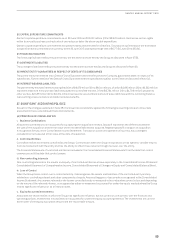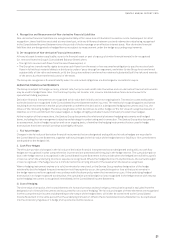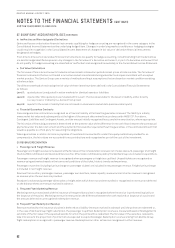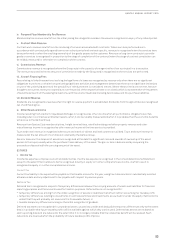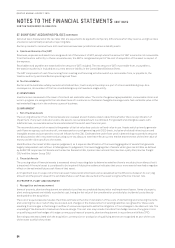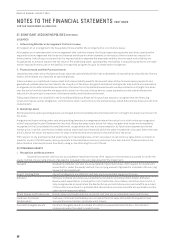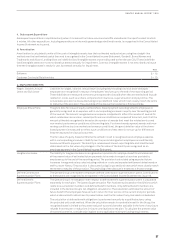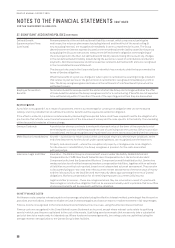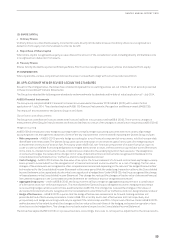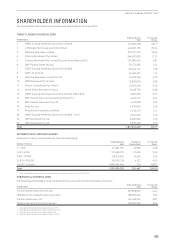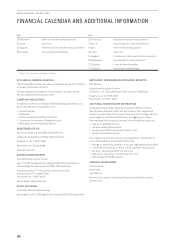Qantas 2015 Annual Report Download - page 100
Download and view the complete annual report
Please find page 100 of the 2015 Qantas annual report below. You can navigate through the pages in the report by either clicking on the pages listed below, or by using the keyword search tool below to find specific information within the annual report.
99
QANTAS ANNUAL REPORT 2015
(O) SHARE CAPITAL
i. Ordinary Shares
Ordinary shares are classified as equity. Incremental costs directly attributable to issue of ordinary shares are recognised as a
deduction from equity, net of any related income tax benefit.
ii. Repurchase of Share Capital
When share capital recognised as equity is repurchased, the amount of the consideration paid, including directly attributable costs
isrecognised as a deduction from equity.
iii. Treasury Shares
Shares held by the Qantas sponsored Employee Share Plan Trust are recognised as treasury shares and deducted from equity.
(P) COMPARATIVES
Where applicable, various comparative balances have been reclassified to align with current period presentation.
38. APPLICATION OF NEW OR REVISED ACCOUNTING STANDARDS
Except for the changes below, the Group has consistently applied the accounting policies set out in Note 37 to all periods presented
in these Consolidated Financial Statements.
The Group has adopted the following new standards and amendments to standards with a date of initial application of 1 July 2014.
AASB 9 Financial Instruments
The Group early adopted AASB 9: Financial Instruments as amended in December 2013 (AASB 9 (2013)) with a date of initial
application of 1 July 2014. This standard replaced AASB 139 Financial Instruments: Recognition and Measurement (AASB 139).
The impact of this standard for the Qantas Group is as follows:
Classification and Measurement
The Group has classified its financial assets and financial liabilities in accordance with AASB 9 (2013). There were no changes in
measurement of the Group’s financial assets and financial liabilities as a result of the changes in classification required by AASB 9
(2013).
Hedge accounting
AASB 9 (2013) introduced a new hedge accounting model to simplify hedge accounting outcomes and more closely align hedge
accounting with risk management objectives. Some of the key improvements in the standard impacting the Qantas Group include:
–Risk components – AASB 9 (2013) permits hedge accounting for a non-financial component of an economic risk that is separately
identifiable and measurable. The Qantas Group uses options and swaps on jet kerosene, gasoil and crude oil to hedge exposure
to movements in the price of aviation fuel. Previously under AASB 139, non-financial components of aviation fuel price, such as
crude oil, were prohibited from being designated as hedged items and as a result, ineffectiveness occurred due to the differences
in the mark-to-market movements of crude oil derivatives compared to the underlying aviation fuel exposure. The designation
of component hedges has reduced the changes in fair value of derivative financial instruments recognised immediately in the
Consolidated Income Statement as ‘ineffective and non-designated derivatives’
–Cost of hedging – AASB 9 (2013) allows the time value of an option, the forward element of a forward contract and any foreign currency
basis spread to be excluded from the designation of a financial instrument and accounted for as a cost of hedging. The fair value
changes of these elements are recognised in other comprehensive income and depending on the nature of the hedged item will either
be transferred to the Consolidated Income Statement in the same period that the underlying transaction affects the Consolidated
Income Statement or be capitalised into the initial carrying value of a hedged item. Under AASB 139, the Group recognised the change
in these elements in the Consolidated Income Statement. This change has reduced the changes in the fair value of derivative financial
instruments recognised in the Consolidated Income Statement as ‘ineffective and non-designated derivatives’
–Aggregated exposures – Under AASB 9 (2013), the Group has the ability to hedge an aggregated exposure that is a combination
of a derivative and a non-derivative exposure. This has allowed the Qantas Group to designate economic hedging relationships
as accounting hedges, which would not have qualified under AASB 139. This change has reduced the changes in fair value of
derivative financial instruments recognised in the Consolidated Income Statement as ‘ineffective and non-designated derivatives’
–Hedge effectiveness – AASB 9 (2013) requires that the hedge effectiveness assessment be forward-looking and does not
prescribe defined effectiveness parameters. Under AASB 139, an entity had to test effectiveness both retrospectively and
prospectively and hedge accounting could only be applied if the relationship was 80 to 125 per cent effective. Under AASB 9 (2013),
ineffectiveness is the extent to which the changes in the fair value or the cash flows of the hedging instrument are greater or less
than those on the hedged item. This change has not had a material impact on the Consolidated Income Statement
The Group has applied AASB 9 (2013) on a prospective basis. Accordingly, there was no retrospective adjustment to the Group results.


